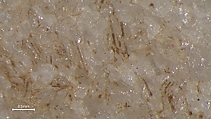On loan to The Met The Met accepts temporary loans of art both for short-term exhibitions and for long-term display in its galleries.
Marble female figure
Technical analysis: Multiband imaging, X-ray radiography, raking light examination, optical microscopy, Raman spectroscopy
The figure is carved from a fine-grained white marble (maximum grain size ≈ 1 mm). It is broken at the neck and the knees and has been repaired. Losses to the proper left shoulder, proper right foot, and near the center of the arms extending to the belly have modern fills. There is a modern fill in the area of the proper right eye and additional shallow losses occur along the proper right arm and at the tip of the nose. The surface exhibits weathering along the grain boundaries with remains of accretions in the interstices. The figure faces forward with arms folded across the front. The legs extend all the way to the arms with no indication of the pelvis or the breasts making the sex of the figure unclear. There is no indication of the knees from the front giving the appearance that the figure is sitting with their arms around the knees but from the back short calves are delineated from the thighs as for a reclining Cycladic folded arm figure. A single vertical groove demarcates the spine and continues down the center of the legs where it is widened to form the inner thighs and calves. The feet are distended as though the figure is reclining and the toes are indicated by shallow grooves. The head is defined sculpturally by its oval chin and prominent central nose, the forehead squared at the top. It sits on a thick neck that rests on broad angular shoulders.
Traces of red, blue and green particles on the surface appear to be modern pigments but there are also indications of the original paint on the figure preserved as ghost impressions. Raking light reveals hanging locks of hair on either side of the back of the head and possibly a cap at the top of the head. When the piece was with the Ariadne Galleries, it was identified as an early hybrid figure dating to the transition from Early Cycladic I to Early Cycladic II, ca. 2800-2700 BCE. However, it is better understood as a later work from the end of the Early Cycladic II period. The treatment of the legs is very unusual and without known parallels.
Seán Hemingway, Dorothy Abramitis, Federico Carò
Due to rights restrictions, this image cannot be enlarged, viewed at full screen, or downloaded.
This artwork is meant to be viewed from right to left. Scroll left to view more.













